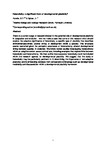Heterokairy: a significant form of developmental plasticity?
| dc.contributor.author | Rundle, Simon | |
| dc.contributor.author | Spicer, John | |
| dc.date.accessioned | 2016-10-25T07:58:58Z | |
| dc.date.available | 2016-10-25T07:58:58Z | |
| dc.date.issued | 2016-09-13 | |
| dc.identifier.issn | 1744-9561 | |
| dc.identifier.issn | 1744-957X | |
| dc.identifier.other | ARTN 20160509 | |
| dc.identifier.uri | http://hdl.handle.net/10026.1/6616 | |
| dc.description.abstract |
<jats:p>There is a current surge of research interest in the potential role of developmental plasticity in adaptation and evolution. Here we make a case that some of this research effort should explore the adaptive significance of heterokairy, a specific type of plasticity that describes environmentally driven, altered timing of development within a species. This emphasis seems warranted given the pervasive occurrence of heterochrony, altered developmental timing between species, in evolution. We briefly review studies investigating heterochrony within an adaptive context across animal taxa, including examples that explore links between heterokairy and heterochrony. We then outline how sequence heterokairy could be included within the research agenda for developmental plasticity. We suggest that the study of heterokairy may be particularly pertinent in (i) determining the importance of non-adaptive plasticity, and (ii) embedding concepts from comparative embryology such as developmental modularity and disassociation within a developmental plasticity framework.</jats:p> | |
| dc.format.extent | 20160509-20160509 | |
| dc.format.medium | ||
| dc.language | en | |
| dc.language.iso | en | |
| dc.publisher | The Royal Society | |
| dc.subject | development | |
| dc.subject | phenotypic plasticity | |
| dc.subject | evolution | |
| dc.title | Heterokairy: a significant form of developmental plasticity? | |
| dc.type | journal-article | |
| dc.type | Journal Article | |
| dc.type | Review | |
| plymouth.author-url | http://gateway.webofknowledge.com/gateway/Gateway.cgi?GWVersion=2&SrcApp=PARTNER_APP&SrcAuth=LinksAMR&KeyUT=WOS:000386646700017&DestLinkType=FullRecord&DestApp=ALL_WOS&UsrCustomerID=11bb513d99f797142bcfeffcc58ea008 | |
| plymouth.issue | 9 | |
| plymouth.volume | 12 | |
| plymouth.publication-status | Published | |
| plymouth.journal | BIOLOGY LETTERS | |
| dc.identifier.doi | 10.1098/rsbl.2016.0509 | |
| plymouth.organisational-group | /Plymouth | |
| plymouth.organisational-group | /Plymouth/Admin Group - REF | |
| plymouth.organisational-group | /Plymouth/Admin Group - REF/REF Admin Group - FoSE | |
| plymouth.organisational-group | /Plymouth/Faculty of Science and Engineering | |
| plymouth.organisational-group | /Plymouth/Faculty of Science and Engineering/School of Biological and Marine Sciences | |
| plymouth.organisational-group | /Plymouth/REF 2021 Researchers by UoA | |
| plymouth.organisational-group | /Plymouth/REF 2021 Researchers by UoA/UoA07 Earth Systems and Environmental Sciences | |
| plymouth.organisational-group | /Plymouth/Research Groups | |
| plymouth.organisational-group | /Plymouth/Research Groups/Marine Institute | |
| plymouth.organisational-group | /Plymouth/Users by role | |
| plymouth.organisational-group | /Plymouth/Users by role/Academics | |
| plymouth.organisational-group | /Plymouth/Users by role/Researchers in ResearchFish submission | |
| dc.publisher.place | England | |
| dcterms.dateAccepted | 2016-08-24 | |
| dc.rights.embargodate | 2017-9-13 | |
| dc.identifier.eissn | 1744-957X | |
| dc.rights.embargoperiod | 12 months | |
| rioxxterms.versionofrecord | 10.1098/rsbl.2016.0509 | |
| rioxxterms.licenseref.uri | http://www.rioxx.net/licenses/under-embargo-all-rights-reserved | |
| rioxxterms.licenseref.startdate | 2016-09-13 | |
| rioxxterms.type | Journal Article/Review |


